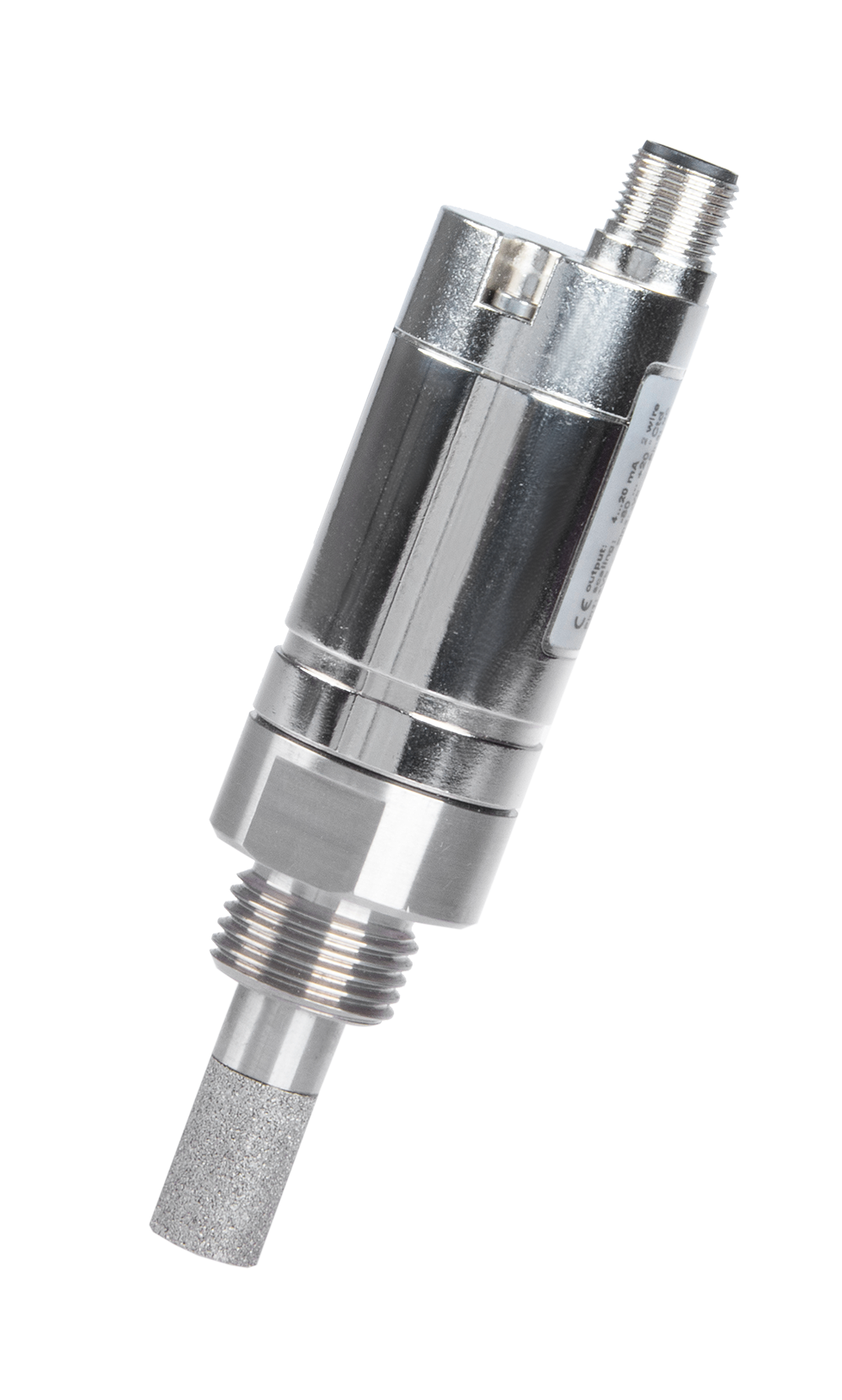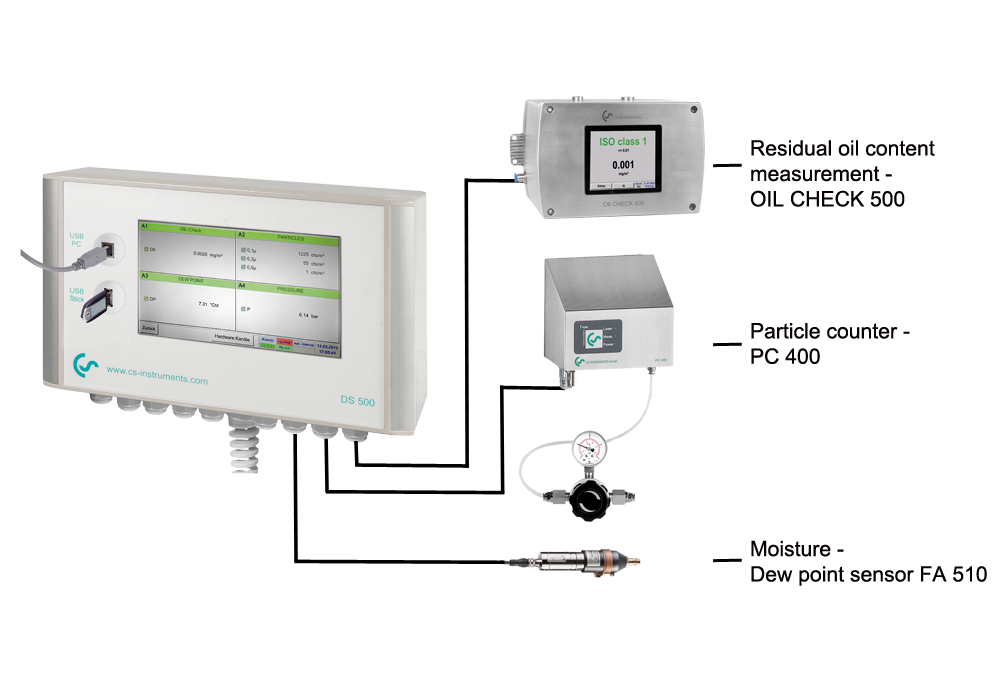
FA 510/515 - Dew point sensor for adsorption dryers
For residual moisture measurement from -80 to 20°Ctd. New: With Modbus RTU interface.
Compressed air is an expensive, but also indispensable medium in industrial, automated production. This makes it all the more important for users to always keep an eye on the quality of their Compressedair systems.
ISO 8573 is an internationally recognised standard that defines the most important impurities in compressed air. The implementation of this standard supports the accurate testing of the most important contaminants in compressed air - Particles, water, Gases, microbiological and oil contaminants.
Some of these methods require samples to be analysed in a laboratory. This always involves time delays and only provides the customer with an average snapshot over the measured period and is not always practical.
So how do we measure these contaminants under everyday, real-life operating conditions?
CS INSTRUMENTS offers customised solutions for stationary and Portable monitoring. Alarms can be used to signal that maintenance work is required on the compressed air treatment system (dryer and filter) so that oil, water and Particles do not enter the compressed air network. This in turn reduces the risk of contamination of end products and increases process reliability and the service life of pneumatic components.

| ISO 8573-1:2010 Class | Oil | Water | Solid particles | ||
| Total Oil (liquid aerosol and mist) | Pressure dew point Steam | Maximum number of Particles per m3 | |||
| mg/m3 | 0.1 - 0.5 μm | 0.5 - 1 μm | 1 - 5 μm | ||
| 0 | As specified by the appliance user, stricter requirements than class 1 | ||||
| 1 | 0,01 | ≤ -70 °C | ≤ 20.000 | ≤ 400 | ≤ 10 |
| 2 | 0,1 | ≤ -40 °C | ≤ 400.000 | ≤ 6.000 | ≤ 100 |
| 3 | 1 | ≤ -20 °C | - | ≤ 90.000 | ≤ 1.000 |
| 4 | 5 | ≤ +3 °C | - | - | ≤ 10.000 |
| 5 | - | ≤ +7 °C | - | - | ≤ 100.000 |
| 6 | - | ≤ +10 °C | - | - | - |
| 7 | - | - | - | - | - |
| 8 | - | - | - | - | - |
| 9 | - | - | - | - | - |
| x | - | - | - | - | - |
In this editorial, we focus on inline methods for the continuous detection of oil aerosols, moisture and Particles (including microbiological contaminants).
With regard to ISO 8573-2, various test methods are approved for Measuring the oil aerosol content.
The following table was taken from the ISO 8573-2 standard document. The following measurement methods correspond to a sample taken over time, so the results can only be used for validation purposes.
| Parameters | Method A - Full Flow | Method B - Full flow | Method B2 - Partial flow |
| Contamination range | 1 mg/m3 to 40 mg/m3 | 0.001 mg/m3 to 10 mg/m3 | 0.001 mg/m3 to 10 mg/m3 |
| Max. Velocities in the filter | See 7.1.2.10 | 1 m/s | 1 m/s |
| Sensitivity | 0.25 mg/m3 | 0.001 mg/m3 | 0.001 mg/m3 |
| Accuracy | ± 10% of the actual value | ± 10% of the actual value | ± 10% of the actual value |
| Max. Max. temperature | 100 C° | 40 C° | 40 C° |
| Test time (typical) | 50 h to 200 h | 2 min to 10 h | 2 min to 10 h |
| Filter structure | Coalescence line filter | Three-layer membrane | Three-layer membrane |
Modern measuring systems such as PID sensor technologies are used for online measurements that provide the user with a continuous display and also an indication of peak contamination. These sensors provide a permanent, highly accurate oil vapour measurement by using the photo-ion detector (PID) method.
The sensors can be easily connected to the compressed air system via a Ball valve or quick coupling and continuously analyse the air. Long-term stability can be ensured by using a catalyst that burns off any hydrocarbons in the air, making the clean air ideal for zero-point calibration during operation.
Measured values are continuous, can be recorded and trigger alarms if limit values are exceeded. This offers significant advantages over temporary measurement methods
The Oil-Check 400 enables permanent, highly accurate measuring of the residual vapour oil content from 0.001 mg/m3 to 2.5 mg/m3. The minimum Measured value of 0.001 mg/m3 means that compressed air quality class 1 (ISO 8573-1) can be monitored. This means that the entire Measuring range can be monitored with the Oil-Check 400.
ISO 8573-3 deals with test methods for measuring humidity. The following table is taken from the ISO 8573-3 standard document:
Table 1 - Test Methods for Measuring Moisture in the Air
| Measurement methods sorted according to their measurement accuracy | Measurement accuracy ±°C | Range for humidity Specified as Pressure dew point ° ° C. | Remark | ||||||||
| Method | Table | -80 | -60 | -40 | -20 | 0 | +20 | +40 | +60 | ||
| Spectroscopic | 2 | a | The detection limit for water vapour is about 0.1 x 10-6 to 1 x 10-6 b | ||||||||
| Condensation | 3 and 4 | 0.2 to 1.0 | |||||||||
| Chemical | 5 | 1.0 to 2.0 | |||||||||
| Electrical | 6, 7 and 8 | 2.0 to 5,,0 | |||||||||
| Psychrometer | 9 | 2.0 to 5.0 | |||||||||
| a The measurement accuracy is not yet available in degrees Celsius. b Volume fraction. c Pressure dew point in ISO 7183. | |||||||||||
The spectroscopy and condensation methods are very accurate, but also very expensive when used as continuous measurement solutions. The chemical and psychrometers are spot checks that cannot be used for continuous measurements.
The most commonly used method for measuring humidity and dew point temperatures is therefore the electrical method. The most commonly used sensors in this category are sensors that measure the change in capacitance at different humidities. This is due to the fact that these sensors offer the largest Measuring range with very high Accuracy and repeatability.
These sensors can also be easily installed via a Ball valve or quick coupling and provide continuous measurements that can be recorded and/or used to trigger alarms when limit values are exceeded.
The FA 510 measures the Pressure dew point down to -80°Ctd. Here too, continuous Measuring ensures that an Alarm can be triggered immediately if the compressed air dryer fails. The sensor enables permanent monitoring of the Compressed air dryer.
ISO 8573-4 deals with test methods for the solid particle content. The following table was taken from the ISO 8573-4 standard document:
| Method | Applicable concentration range particles/m3 | Applicable solid particle diameter μm | |||
| < 0,1 | 0,5 | 1 | < 5 | ||
| Laser particle counter | 0 -105 | ||||
| Condensation core counter | 102 -108 | ||||
| Analyser for particle mobility | - | ||||
| SMPS spectrometer/ particle size spectrometer | 102 -108 | ||||
| Sampling on the membrane surface in conjunction with a microscope | 0 -103 | ||||
The most commonly used test method for measuring the solid particle content is realised by counting the particles using a laser particle counter. The sensors can be easily connected to the compressed air system via a Ball valve or a quick coupler and continuously analyse the air. Accuracy is influenced by the size of the laser diode and optics used as well as the Flow rates through the device. The higher the volume of air that can be analysed at a given time, the higher the Accuracy achieved.
Some laser particle counters only measure up to a particle size of 0.3 μm (micrometres). This is not sufficient for the food industry, as particle sizes down to 0.1μm must be detected in order to determine the ISO 8573-1 class.
The high-precision, optical particle counter PC 400 measures Particles from a size of 0.1 μm and is therefore suitable for monitoring compressed air quality class 1 (ISO 8573-1).
The centrepiece of the compressed air quality measurement is the DS 500 Chart recorder, where the measurement data from the sensors for residual oil, Particles and residual moisture are measured and documented. Measured values are displayed graphically on the 7" colour display.
The curves since the start of Measuring can be viewed with a simple finger movement. The integrated Data logger stores the Measured values safely and reliably. The limit value can be freely entered for each measured parameter. 4 alarm relays are available for signalling when limit values are exceeded. The DS 500 can optionally be equipped with up to 12 sensor inputs.
The DS 500 has an Ethernet interface and an RS 485 interface for connection to higher-level systems. Communication takes place via the Modbus protocol.
